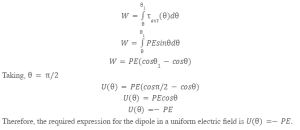The work that needs to be done to move a unit charge from one point to another against the electric field is called the electric potential. F= qE is the force exerted by the electric field on the positive charge. The equal and opposite amount of force needs to be exerted i.e, F= -qE on the charged particle to move it from one point to another. The amount of work done in moving a charged particle is W= -qEd. The potential energy associated with a positively charged particle depends on its movement either against or with the electric field. The potential energy increases when moved against an electric field whereas it decreases when moved with the electric field. But in the case of a negatively charged particle, potential energy increases when moved with the electric field and decreases when moved against the field. Electric potential is the potential energy per unit charge. The difference in potential energies at any point gives us the work done in moving the same charge from one place to another. A voltmeter is used for measuring electric potential energies.
Electric Potential Energy
The energy possessed by an object because of its position or height is called potential energy like, cells and batteries have energy stored in them which is the potential energy. Like charges repel each other and unlike charges attract each other, whether it is attraction or repulsion, force is exerted in this case, and as a result potential energy arises due to the collection of charges. Let’s take an example of two positive charges which would of course repel each other when brought closer and the potential energy comes into existence. The potential energy of two charges present close to each other is given by
U=kQq/r
Derivation of electric potential energy in the two-charge system
Consider a test charge q and a source charge Q. Imagine these charges lie on the same line and A and B are the two points on that line. Let’s calculate the work done when the test charge is made to move towards the source charge.
W=AB∫Fdl
The electric force Fe is balanced by the applied force F and it is equivalent to
F=Fe=-(kqQ/r2)r
Therefore, U=kQq/r
The distance from the origin is denoted by the r. In the system above, the applied force and the direction in which the test charge moves, both are positive. Therefore, the work done on the system will also be positive. Conservative forces doing negative work will increase the potential energy of the system whereas, conservative forces doing positive work decrease the potential energy of the system which results in the release of energy.
The electric potential energy of a system of three particles can be calculated similarly and it’s equal to
U=k(q1q2/r12+q1q3/r13+q2q3/r23)
Electric potential energy of a dipole in a uniform electric field
Suppose a dipole in a uniform electric field with charges +q and -q. The dipole experiences a torque given by
=PE
This will rotate the dipole. Now let’s suppose, external torque is applied and that balances the effect of previous torque such that it changes its angle from to 1.
The work done by the external torque is given by
W=1ext()d
W=1PEsind
W=PE(cos1-cos)
Taking, =/2
U()=PE(cos/2-cos)
U()=PEcos
U()=-PE
Therefore, the required expression for the dipole in a uniform electric field is U()=-PE
Problems
- The distance between a +2 C and a +3 C charge is 20 cm. Both being positive,they will repel each other such that +3 C charge reaches at a distance of 30 cm. What is the change in the potential energy?
Using, U=-r1r2F.dr
=-r1r2kQq/r2.dr
=kQq{1/r2 -1/r1}
Plugging in the given values, we have
=9*109*2*3{1/0.3 +1/0.2}
=449.82*109 joules
- Through a potential difference of 5 volts, 2 C charge is moved. Calculate the change in electric potential energy.
Electric potential is the potential energy per unit charge.
Therefore, V=U/q
5=U/2
U=10 joules
Conclusion
If both the charges are either positive or negative, the electric potential energy will always be positive but in the case of charges being of the opposite nature, the potential energy will always be negative. Positive work increases the potential energy of the system and negative work decreases the same. Also, potential energy is inversely proportional to the distance. So, as the distance between the charged particles increases, the potential energy decreases, and when the distance decreases, the potential energy decreases.
 Profile
Profile Settings
Settings Refer your friends
Refer your friends Sign out
Sign out







